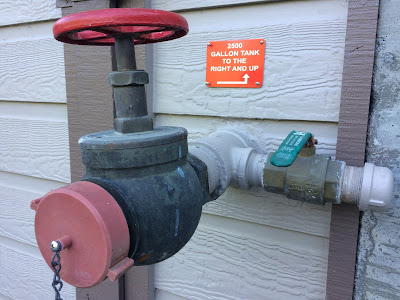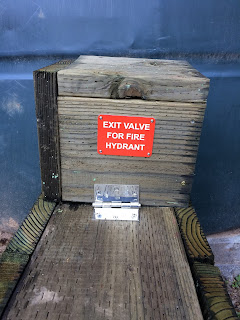FIRE SAFETY TIPS!
MANY YOU PROBABLY DO NOT KNOW!
Store your fire extinguisher at least 10 feet from a fire
source such as a refrigerator, freezer, floor-wall or central heater, hot water
heater, dryer, oven or stove. If a fire
starts by one of these, you may not be able to get to the extinguisher due to
the intense heat. Be sure everyone
knows where it is located. Many people store the extinguisher in the kitchen
under the sink which is usually close to a fire source, hard to find and may
have other items in front of it which will waste valuable time in an
emergency.
Know how to use your fire extinguisher. There is a pin at the top that will prevent
accidental discharge. The pin must be
pulled for the extinguisher to work.
When spraying at a fire, spray at the base of the flame, not at the
flames. The fire is lower.
Check your fire extinguisher gage at least two times per
year to see if there is enough pressure.
Also shake the extinguisher at the same time to see if the powder is
loose. If you do not hear the powder
move or if the pressure gage indicates it is low, please have your extinguisher
serviced. The extinguisher should be
replaced approximately every 10 years.
If you can afford a fire extinguisher for your car, please
purchase one. I have been able to use
mine on a car fire and also on a beginning brush fire alongside the
freeway. It is particularly important to
shake the fire extinguisher regularly to be sure the powder is loose if you
keep it in a vehicle or a boat. The
vibration in the vehicle or boat can pack the powder.
Do not dry items close to any heater. As they dry the items can start to move and
fall off the rack or combust.
Do not store combustible items in a water heater or furnace area. You need a minimum of 3 feet clearance to
reduce the chance of a fire. I was an
insurance agent for almost 40 years. It
was common to see items stored in these areas and it would block the air vents
to the gas appliance. This is especially
critical if the appliance was in a confined space such as a closet. A minimum of 50 square inches high and 50
square inches low or more is needed for proper ventilation. People can die without proper ventilation
which can cause carbon monoxide poisoning. Please check your local building
codes.
Check your smoke detector and carbon monoxide detectors
batteries at least once a year. Some
people check them on daylight savings time changes.
Change the filters on your heater at least annually. I have seen filters so clogged, it could
restrict the air flow to the appliance and cause it to overheat. A clean filter will also improve the quality
of air into your home and reduce electrical costs by making your furnace
operate more efficiently.
Clean your dryer vents at least annually. The longer the run to the outside of the
home, the more frequently you need to check.
This will keep the lint from building up in the line and help prevent a
dryer fire.
If you have a wood stove, clean your chimney at least once a
year. Buildup of creosote can occur over
time which can cause a chimney fire.
When you start your stove, don’t immediately choke it down. Let it get the chimney hot which will help
keep the chimney cleaner. If you burn
wood that has a lot of pitch, cleaning more often should be considered.
If you have a security alarm in your home for burglary it
should be easy to add one or more smoke detectors to your system. A burglar takes a few things and fire can
take everything. If you are already
paying a monitoring fee, it should not increase your monthly fee to add this
feature. The only cost should be the
cost and installation of the detector.
I was an insurance agent for 39 ½ years and on each fire
loss, people were amazed at how much they could NOT remember about what they
owned. Take photos on the outside and
inside of your home every 5 years or sooner. Upload them to the cloud or get
them out of your home for safe keeping. When you take interior photos, open
every cupboard and drawer. It will help
you document and remember what your owned.
This could mean thousands of dollars in extra payments to you. Your insurance company does not know what you
owned. If you have a special item or
items, take close up photos of them including serial numbers on guns, TV’s and
other high valued contents. Write the serial numbers on a post it note and
put it on the item or close to it so it will be in the photo.
If you can afford a fire proof or resistant safe, put all of
your precious photos and videos in it. Those
items cannot be replaced. Losing those
items after a fire was the most upsetting thing to my clients.
Be careful when cleaning or moving items so you do not put
them on top of an extension or other electrical cord. One client was cleaning, moved their couch
and accidentally put it on top of the cord to a light. Eventually the pinched cord caused a major
fire.
Do you live in an outlying area where you have a water tank
with an outlet for the Fire Department?
Check your tank annually. I had a
pin hole leak in my tank and 75% of the water had drained out over time. You need the tank full if there is a
fire. Also turn the filler valves and
exit valves at least once a year to be sure they are not frozen.
Below you will see a photo of my fire tank. Please note I have cleared all brush at least
30 feet from my tank and raked the ground. Also trim the trees up so the
branches are not close to your tank.
Please note my tank did not have any protection around the filler or
exit lines. It is necessary to protect
these lines from damage from falling branches, trees and animals.
I just added the protection to my filler and exit
lines. (See photo below) They have been unprotected since I installed
the tank in 1995. I was lucky. If my filler line to the tank would have been
damaged, I would have had to turn off all water to my home until I fixed
it. Even if I did not have a fire, it
would have inconvenienced me and my family until it was repaired. If I had a fire, I may not have had any water
to fight the fire until the Fire Department arrived.
Make signs for the Fire Department to help them if they
respond to a fire at your home. You may
not be at your home during a fire. It
may also be at night and/or your water tank may not be readily visible to the
Fire Department. There may be other
essential information that can be displayed to assist the Fire Department.
Every second counts. Even a minute can make a big difference.
Doing everything you can to assist the Fire Department will help them help
you. It will also make it safer for the
men and women who risk their lives to help you.* All content of this site was developed by Paul Nicholson through his dedication to 911 education since 2001, no other person or company is responsible for this site content. All content provided herein is for educational purposes only. It is provided "as is" and Paul does not warranty the information provided nor does he assume any responsibility for errors, omissions or contrary interpretation of the subject matter herein. Paul Nicholson is a retired insurance agent with over 39 years of experience.






